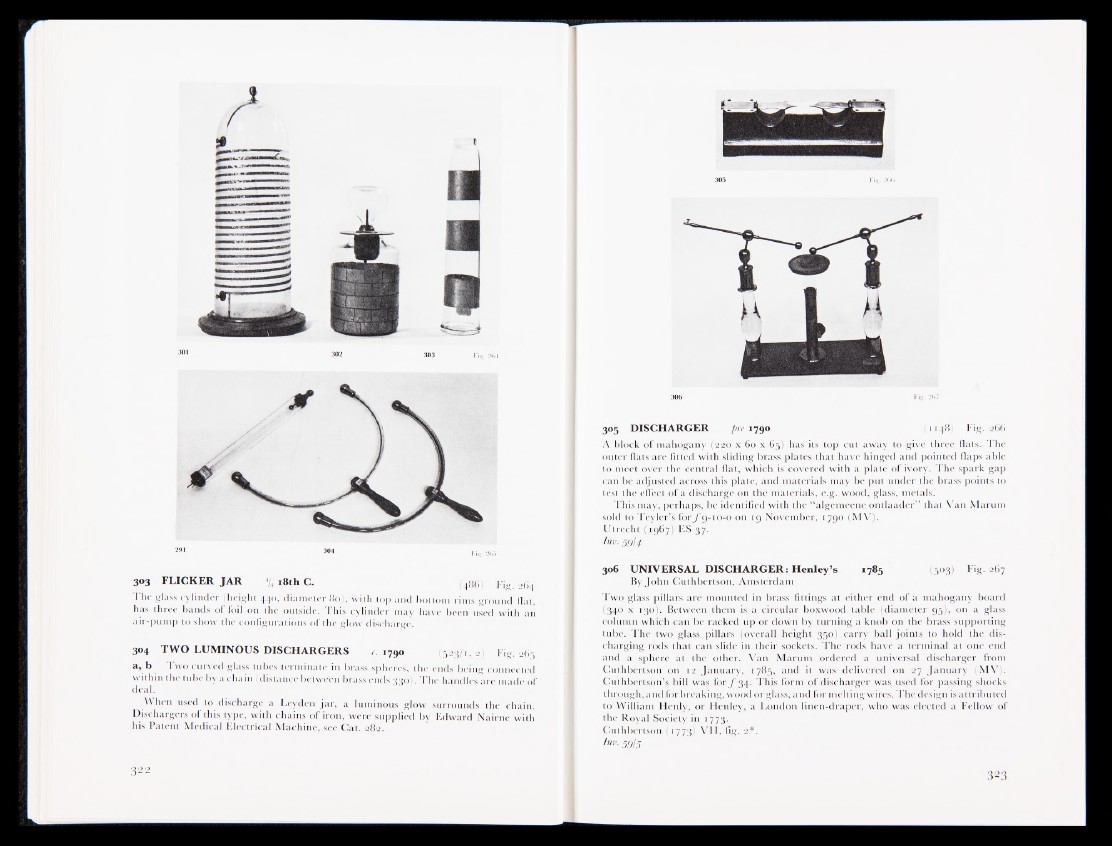
303 FLICKER JAR */4 18th C. (4afj) p;g 2g4
I he glass cylinder (height 440, diameter 80), with top and bottom rims ground llal,
has three bands of foil on the outside. This cylinder may have been used with an
air-pump to show the configurations of the glow discharge.
304 TWO LUMINOUS DISCHARGERS c. 1790 (523/1, 2) Fig. 263
a, b Two curved glass tubes terminate in brass spheres, the ends being connected
within the tube by a chain (distance between brass ends 330). The handles are made of
deal.
When used to discharge a Leyden jar, a luminous glow surrounds the chain.
Dischargers of this type, with chains of iron, were supplied by Edward Nairne with
his Patent Medical Electrical Machine, see Cat. 282.
306 Fij{. -’6 '
305 DISCHARGER pre 1790 (] 148) l’ig. 26b
A block of mahogany (220 x 60 x 65) has its top cut away to give three flats. The
outer flats are fitted with sliding brass plates that have hinged and pointed flaps able
to meet over the central fiat, which is covered with a plate of ivory. The spark gap
can be adjusted across this plate, and materials may be put under the brass points to
test the effect of a discharge on the materials, e.g. wood, glass, metals.
This may, perhaps, be identified with the “ algemeenc ontlaader” that Van Marum
sold to Teyler’s forjfo-to-o on to November, 1790 (MV).
Utrecht (1967) ES 37.
Inv. jg/4
306 UNIVERSAL DISCHARGER: Henley’s 1785 (503) ffig. 267
By John Guthberlson, Amsterdam
Two glass pillars are mounted in brass fittings at either end of a mahogany board
(340 x 130). Between them is a circular boxwood table (diameter 95), on a glass
column which can be racked up or down by turning a knob on the brass supporting
tube. T he two glass pillars (overall height 350) carry ball joints to hold the discharging
rods that can slide in their sockets. T he rods have a terminal at one end
and a sphere at the other. Van Marum ordered a universal discharger from
Cuthbertson on 12 January, 1785, and it was delivered on 27 January (MV).
Culhbertson’s bill was for ƒ 34. This form of discharger was used for passing shocks
through, and for breaking, wood or glass, and for melting wires. The design is attributed
to William Henly, or Flenley, a London linen-draper, who was elected a Fellow of
the Royal Society in 1773.
Cuthbertsonw 773) VII, fig- 2*.
■ 59b